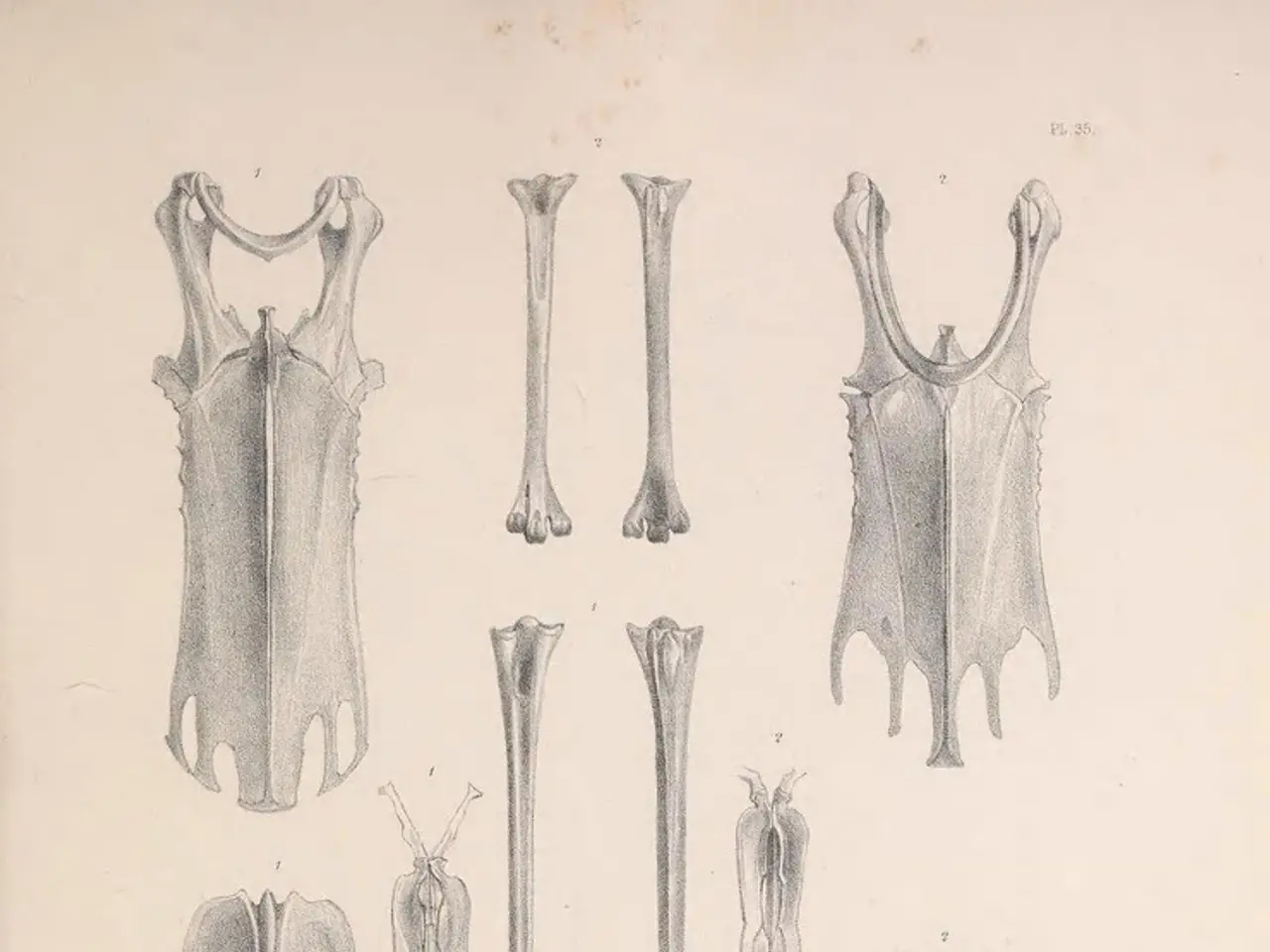Genetic Abnormalities in Kearns-Sayre Syndrome: Varieties and Impact on Cellular Functions
Kearns-Sayre Syndrome (KSS) is a rare, chronic, and progressive condition that primarily affects the mitochondria, the energy-generating organelles in cells. This condition arises due to a spontaneous mutation in mitochondrial deoxyribonucleic acid (mtDNA), leading to a variety of symptoms.
Common Symptoms of KSS
The most prominent symptoms of KSS include progressive external ophthalmoplegia, pigmentary retinopathy, and ptosis. Progressive external ophthalmoplegia is the weakness or paralysis of the eye muscles, leading to limited eye movement. Pigmentary retinopathy is the degeneration of the retina, causing vision impairment, while ptosis refers to the drooping of the eyelids.
Other symptoms may include muscle weakness, hearing loss, and endocrine disorders. Cardiac conduction defects, which can be serious, are also common in KSS patients. Onset typically occurs before the age of 20.
Treatment and Management
Currently, there is no cure for KSS as it is a mitochondrial genetic disorder. Management focuses on monitoring and treating symptoms as they arise. Regular cardiac evaluation is essential due to the risk of conduction defects. Supportive therapies may include ophthalmic care for eye muscle issues and retinal degeneration, and consultation with specialists such as neurologists or geneticists is recommended for ongoing care and genetic counseling.
Mitochondrial Augmentation Therapy (MAT)
Recently, Mitochondrial Augmentation Therapy (MAT) has shown promising results in improving symptoms for KSS patients. This therapy involves the transplantation of healthy mitochondria into affected cells.
Understanding Mitochondria and mtDNA
Mitochondria are large organelles that generate energy in the form of adenosine triphosphate (ATP). Mitochondrial DNA (mtDNA) is a double-stranded DNA that exists in a circular structure. It consists of 37 genes which code for 13 proteins essential for aerobic respiration. RNA, which presents a wider variety of forms - rRNA and tRNA - compared to DNA, plays a crucial role in protein synthesis within the mitochondria.
Diagnosis and Deletions in KSS mtDNA
Patients with KSS are diagnosed based on the presence of onset of symptoms below the age of 20, external ophthalmoplegia, and retinitis pigmentosa. The deletions in KSS mitochondrial DNA are large-scale and involve the removal of base-pairs, ranging from 1,100 to 10,000 bases. These deletions interfere with the synthesis of mitochondrial proteins, rRNA, or tRNA, hindering the ability of the mitochondria to produce sufficient amounts of ATP.
Living with KSS
Patients with cardiac symptoms may need pacemakers for managing their heart block and yearly ECGs and monitoring. Patients presenting with hearing loss may benefit from cochlear implants. Hormonal imbalances can be treated with hormone replacement therapy (HRT), depending on the affected hormone or endocrine gland. Folic acid supplements are recommended for patients with a low amount of cerebrospinal fluid.
In summary, Kearns-Sayre Syndrome presents primarily with progressive eye muscle paralysis and retinal degeneration, accompanied by other systemic features. Treatment is symptomatic and supportive, emphasizing regular monitoring, especially of heart function. Understanding this rare condition is crucial for early diagnosis and appropriate management.
[1] Source for common symptoms: National Institutes of Health (NIH) - Genetic and Rare Diseases Information Center (GARD) [2] Source for treatment and management: Orphanet Journal of Rare Diseases [3] Source for Mitochondrial Augmentation Therapy: Nature Reviews Neurology [4] Source for understanding mitochondria and mtDNA: NCBI - National Center for Biotechnology Information [5] Source for diagnosis and deletions in KSS mtDNA: Journal of Medical Genetics [6] Source for living with KSS: European Journal of Paediatric Neurology
- Kearns-Sayre Syndrome (KSS) is a chronic and progressive condition that primarily affects the mitochondria in cells.
- This condition arises due to a spontaneous mutation in mitochondrial deoxyribonucleic acid (mtDNA), leading to a variety of symptoms.
- The most prominent symptoms of KSS include progressive external ophthalmoplegia, pigmentary retinopathy, and ptosis.
- Progressive external ophthalmoplegia is the weakness or paralysis of the eye muscles, leading to limited eye movement.
- Pigmentary retinopathy is the degeneration of the retina, causing vision impairment.
- Ptosis refers to the drooping of the eyelids in KSS patients.
- Other symptoms may include muscle weakness, hearing loss, and endocrine disorders.
- Cardiac conduction defects, which can be serious, are also common in KSS patients.
- Onset typically occurs before the age of 20.
- Currently, there is no cure for KSS as it is a mitochondrial genetic disorder.
- Management focuses on monitoring and treating symptoms as they arise.
- Regular cardiac evaluation is essential due to the risk of conduction defects in KSS patients.
- Supportive therapies may include ophthalmic care for eye muscle issues and retinal degeneration.
- Consultation with specialists such as neurologists or geneticists is recommended for ongoing care and genetic counseling.
- Mitochondrial Augmentation Therapy (MAT) has shown promising results in improving symptoms for KSS patients.
- This therapy involves the transplantation of healthy mitochondria into affected cells.
- Mitochondria are large organelles that generate energy in the form of adenosine triphosphate (ATP) in cells.
- Mitochondrial DNA (mtDNA) is a double-stranded DNA that exists in a circular structure, consisting of 37 genes which code for 13 proteins essential for aerobic respiration.
- RNA plays a crucial role in protein synthesis within the mitochondria.
- Patients with KSS are diagnosed based on the presence of onset of symptoms below the age of 20, external ophthalmoplegia, and retinitis pigmentosa.
- The deletions in KSS mitochondrial DNA are large-scale and involve the removal of base-pairs, ranging from 1,100 to 10,000 bases.
- These deletions interfere with the synthesis of mitochondrial proteins, rRNA, or tRNA, hindering the ability of the mitochondria to produce sufficient amounts of ATP.
- Patients with cardiac symptoms may need pacemakers for managing their heart block and yearly ECGs and monitoring.
- Patients presenting with hearing loss may benefit from cochlear implants.
- Hormonal imbalances can be treated with hormone replacement therapy (HRT), depending on the affected hormone or endocrine gland.
- Folic acid supplements are recommended for patients with a low amount of cerebrospinal fluid.
- Understanding this rare condition is crucial for early diagnosis and appropriate management.
- Living with KSS can involve managing cardiac issues, vision impairment, hearing loss, and hormonal imbalances through regular monitoring, therapy, and support from healthcare professionals.




